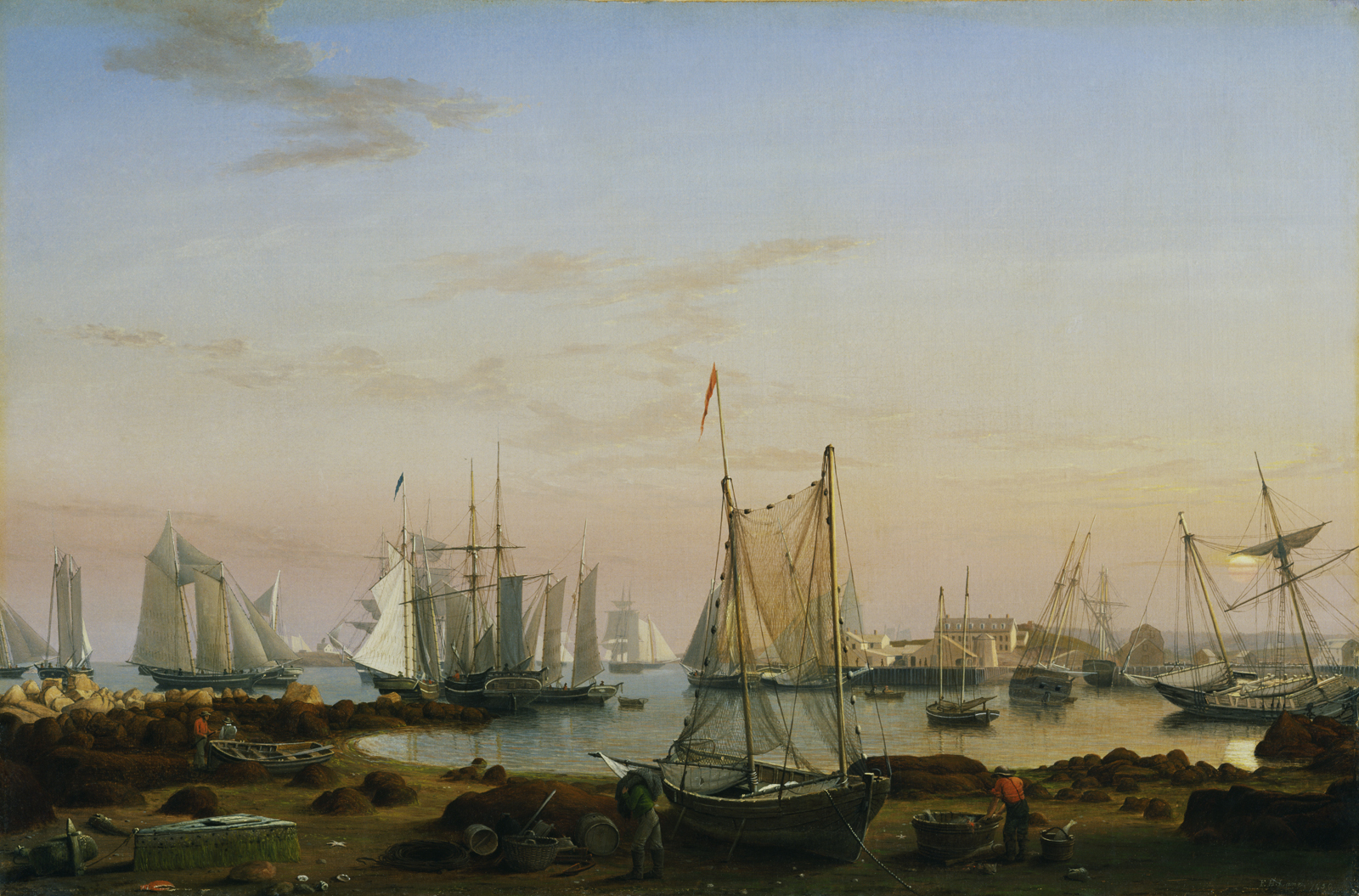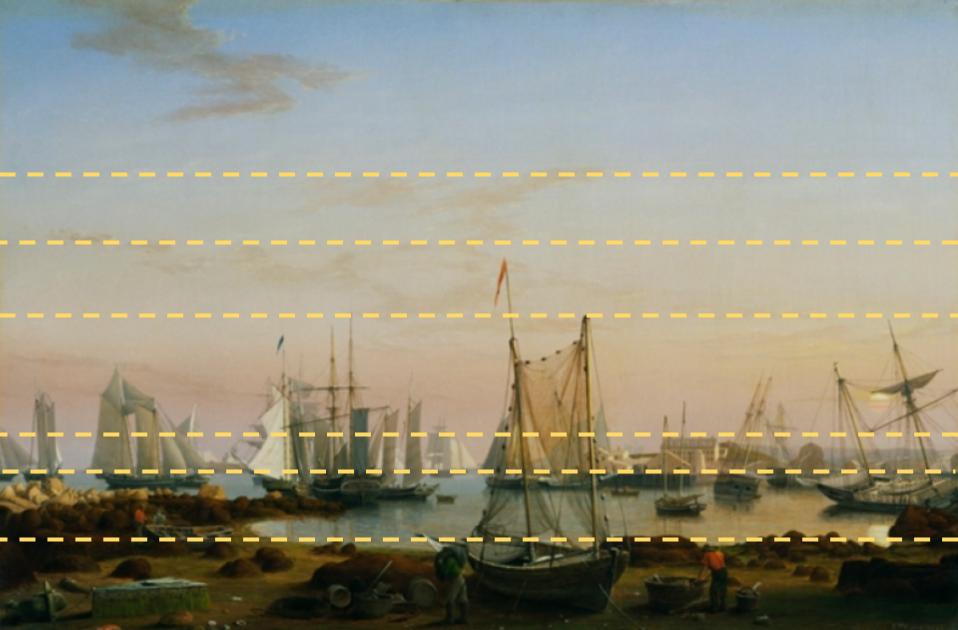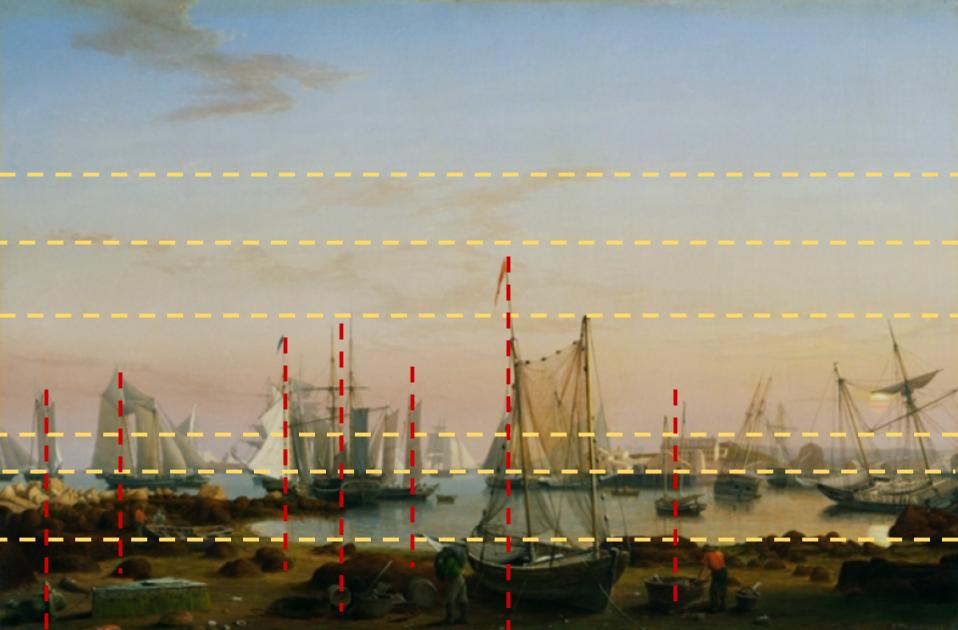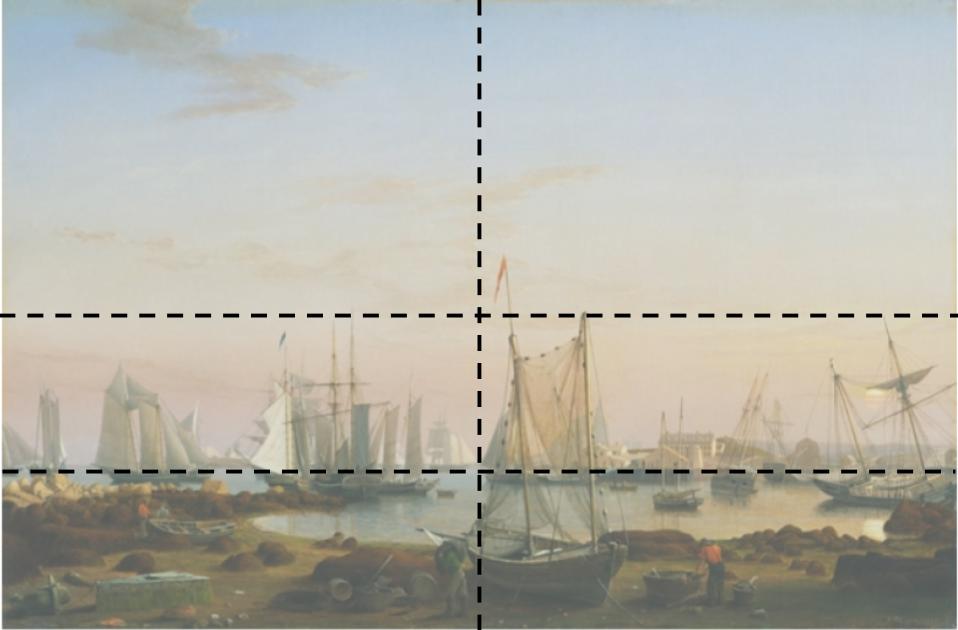The setting sun casts the last of its delicate golden rays over the Gloucester Inner Harbor, bringing an end to the day’s work. The harbor is filled with boats, but at low tide, many of them list lazily in the water or on shore as if they’ve been tucked up for the evening, the workers finishing their tasks, surely getting ready to head home after a long day. The sunset is rich and warm and the sky fades from the last bits of periwinkle blue to a cozy red dappled with gold.
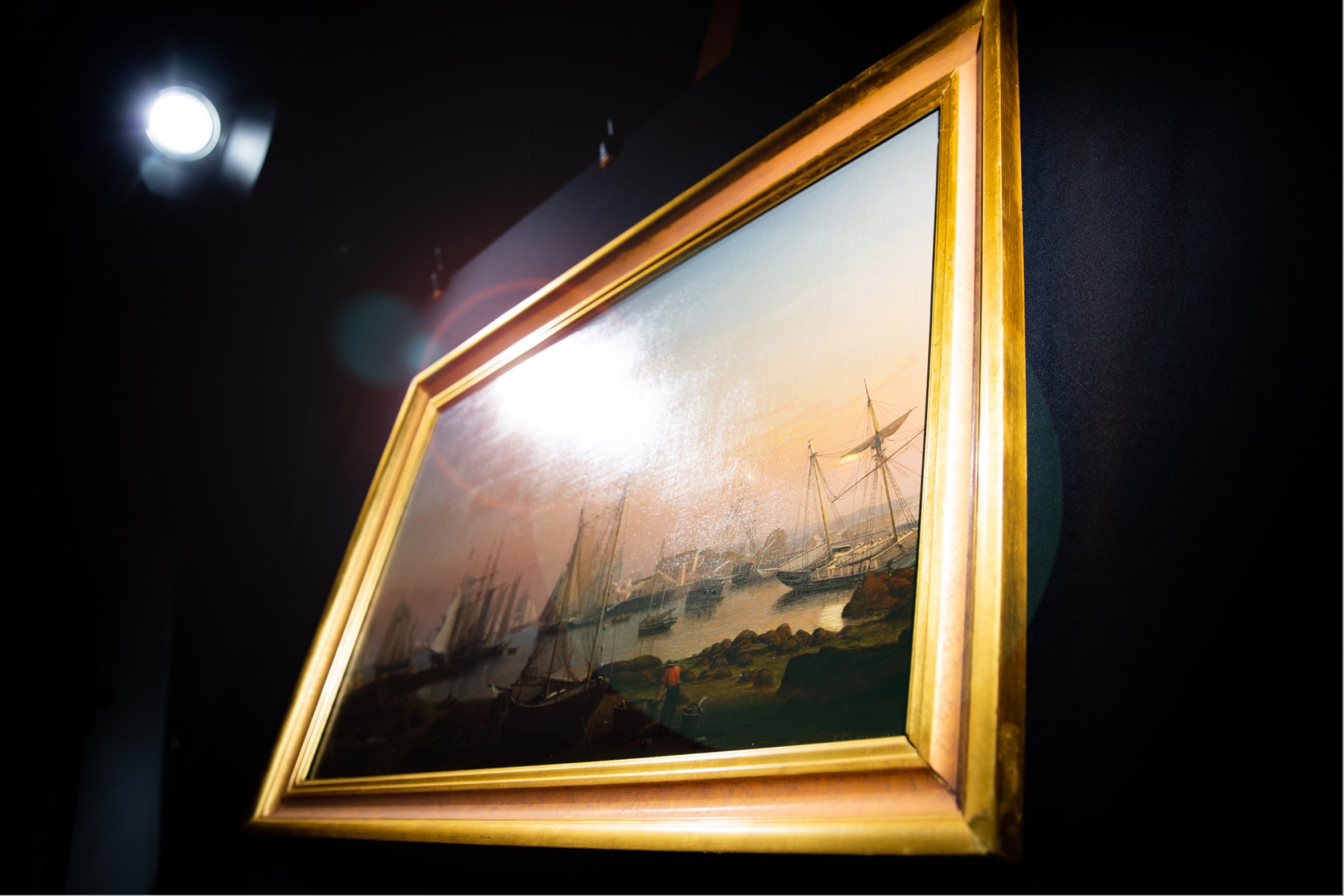
Where to Begin?
When I first began working on this series, I met with Jeanne, our Director of Collections Management, to ask her if she might show me some of her favorite pieces from the collection. I knew that, although my journey into the collection was really just beginning, she had years of experience with it! As she pulled out rack after rack of paintings, I scribbled down accession numbers and while there were so many pieces that I knew I wanted to talk about, there was one that really stuck with me for a number of reasons.
First, I wanted to make good on my promise to you for this series… “We’re going to go into the galleries and behind the scenes” so I knew that for our first adventure together I wanted to select a work from painting storage. This is a room that has been truly transformative for me in my career at The Mariners’ Museum. The wonder and inspiration that it seems to radiate never fails to amaze me, and I want you to be able to feel that too.
Secondly, I wanted to start somewhat close to home with an American Artist and with a happy piece. One thing you’ll come to learn about me is that I LOVE really dramatic works of art and we’ll get to those. For this first episode, though, I wanted to talk about looking deeper, beyond the surface of a “pretty painting”
Which brings me to this piece, this is Fitz H. Lane’s 1850 oil on canvas, entitled “Gloucester Inner Harbor”.
The life of Fitz Henry (yes, Henry) Lane
Lane was born in Gloucester, Massachusetts in 1804 where he was raised, lived most of his life, and eventually passed away from bladder cancer in 1865. One of the many things I find fascinating about this artist is his name, which has caused quite a bit of confusion. Born Nathaniel Rogers Lane, he legally changed his name (for reasons unknown) to Fitz Henry Lane in 1831. Turns out scholars aren’t always right as he was wrongly known as Fitz Hugh Lane until 2005 when it was discovered that we’d had the wrong name all along! The painting we have in our collection is signed “F. H. Lane”.
He was the son of a sailmaker and was constantly exposed, for the entirety of his life, to the water. He showed great skill in art, and although the information on Lane’s upbringing is murky at best, it’s believed that he may have sought formal artistic training in Gloucester and at the age of 27, in 1832, moved to Boston to apprentice at Pendleton’s lithography shop under William and John Pendleton where he received formal training. Later moving to another firm and then establishing a partnership of his own with John W.A. Scott, a painter and lithographer associated with the Hudson River School. While Lane’s lithography career continued throughout his life, it certainly took a back seat to his painting career in the late 30’s and by 1940, Lane had established himself as a marine painter, and a good one at that!
He returned to Gloucester in 1848 where he , with the help of his brother, built a stone home atop a small hill looking out over this same harbor.
Let’s Break it Down
Looking at this work, we’re immediately struck by a stillness that feels, not stagnant, but rather meditative and peaceful. This stillness comes from the many horizontal lines that run through this piece. We see them in the clouds that don’t puff up, but rather spread out wispily in the sky, and in the horizon, the water, and the shore.
The vertical lines of the masts on the vessels in the harbor break up the horizontal lines but they, too, add a calm that grounds the work.
The stillness can also be partially attributed to the composition of the piece. It is measured, and mathematical in a way. It can be divided almost perfectly into 4 quadrants.
Lengthwise, the central boat sits just right of center, and the weight of the composition is balanced, meaning one side of the work doesn’t have more light, dark, or subject matter than the other. When divided widthwise, the top half consists solely of sky with only the small red pennant and the very tips of two other masts as minor intrusions. In the lower part of the painting, the horizon line divides that half again, another measured choice.
But this precise division should not be, in this piece, mistaken for a lack of emotion.
Lane and Luminism
The colors are warm and harmonious, depicting the few minutes at the end of the day in which everything seems to be bathed in a wash of luminous golden light. This is a quality of Luminism, the artistic movement with which Lane is associated. This label came nearly a century after his death, which this isn’t uncommon. The Luminist Movement is an American Art movement dated from ca. 1840-1870. It is typically classified as an offshoot of Romanticism and is kin to the Hudson River School of landscape painting.
Luminist artists attempted to show the harmonious balance of man and nature through the depiction of light. Lane, in addition to showing the effects of changing light, was also interested in showing the changes in his beloved hometown. He felt strongly connected to, and in harmony with, his hometown in the same way other Luminists felt a strong connection with nature. Throughout his life, Fitz H. Lane watched Gloucester’s economy and harbor grow, fade, and the latter even be consumed with fire. He moved to Boston for about 17 years, during which time Gloucester developed a strong trade with the Dutch colony in Suriname, and by the time Lane returned, commerce was booming.
Looking Deeper
Upon first glance, it could be easy to pass this piece off as just a pretty painting of a harbor. But to do that would miss a crucial element of this work that enhances it, and that is the deep emotion the artist has for this particular setting. If we look back at how we’ve described these elements: meditative, peaceful, calm, balanced, harmonious, we realize that these are feelings that come from a happy place within us. Like when you’re in you’re favorite spot and everything seems perfect, the smells are sweeter, the sounds are music to your ears, the light hits just right, and your soul is soothed.
Fitz H. Lane became ill and lost most of the use of his legs as a very young child and as a result, while growing up, it’s believed that he turned to activities like drawing to fill his days. While it absolutely impacted his life in ways we will never know, Lane never let his disability stand in his way. As mentioned earlier, he had several careers, he travelled and even built his own home. And through his life, he pursued Art above all other careers. Being born and raised in Gloucester, Massachusetts with this bustling harbor nearby, Lane was able to spend his time watching that harbor, the workers, and the ships all the while honing his skill as an artist. This same harbor is seen many times in his works throughout his career as an artist. We see it change over the years and this piece shows it fleshed out with infrastructure, buildings now standing on the island in the background where previously there was an empty hill; the harbor full of the signs of commerce and busier than ever. The home he built still stands today on the shore nearby.
This harbor was the backdrop for his life.
And learning that transformed this painting for me. While it maintained its meditative calm, the light began to dance across the sails. I can imagine sitting here with him at the harbor watching the comings and goings of the ships and the tide, the clouds and the sun. Together we watch the morning turn to afternoon and afternoon to evening as the sun rises and falls in the sky like a timelapse of the day.
The serenity that Lane has imbued is poignant and shows us that this was his “happy place”. We sit together now – you, me, and Lane – in silence and stillness, in this happy place, watching the sun slip from the sky and for a moment there’s peace.

Check out the Full Episode below and don’t miss new episodes the first Friday of each month!
